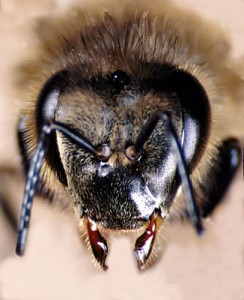Reynolds Professor of Developmental Neuroscience and Chairperson
B.A., University of Pennsylvania, 1977
M.A., Oxford University, 1979
Ph.D., The Rockefeller University, 1985
026 Winston Hall
(336) 758-5023
fahrbach@wfu.edu
Areas of Interest
Development of the nervous system, neuroanatomy, social Insects
Research
My laboratory’s research is on the regulation of form (neuroanatomy) and function (physiology, gene expression) in the nervous system. We use insect models to study how hormones and experience “fine tune” the brain during and after metamorphosis. Current research focuses on the honey bee, Apis mellifera, which we use a model for studies of how learning changes the brain. The complex behavior of honey bees allows us to study brain/behavior relationships in a natural, non-laboratory context. Our research tools include immunocytochemistry, classic neuroanatomical methods such as the Golgi technique, and modern molecular approaches including in situ hybridization, quantitative RT-PCR, and the regulation of gene expression in cultures of primary neurons. We have recently extended our studies to the effects of neuroactive pesticides on brain structure and gut function in the honey bee.
Selected Recent Publications
SE Fahrbach, BN Van Nest. 2016. Synapsin-based approaches to brain plasticity in adult social insects. Current Opinion in Insect Science 18: doi.org/10.1016/jcois.2016.08.009.
SE Fahrbach, AM Trawinski, RA Velarde. 2016.Actions of developmental hormones in adult social insects. Hormones, Brain and Behavior, Third edition, Elsevier, Oxford, UK.
C Forkpah, LR Dixon, SE Fahrbach,O Rueppell. 2014. Xenobiotic effects on intestinal stem cell proliferation in adult honey bee (Apis mellifera) workers. PLoS One. 9:e91180.
SE Fahrbach. 2013. Developmental Neuroscience: A Concise Introduction. Princeton University Press. 292 pp.
DE Wilson, V Mommaerts RA Velarde, SE Fahrbach, G Smagghe. 2013. Use of primary cultures of Kenyon cells from bumblebee brains to assess pesticide side effects. Archives of Insect Biochemistry and Physiology 84:43-56.
SE Dobrin and SE Fahrbach. 2012. Visual associative learning in restrained honey bees with intact antennae. PLoS One 7: e37666.
SE Dobrin and SE Fahrbach. 2012. Rho GTPase activity in the honey bee mushroom bodies is correlated with age and foraging experience. Journal of Insect Physiology 58: 228-234.
SE Fahrbach, G Smagghe, and RA Velarde. 2012. Insect nuclear receptors. Annual Review of Entomology 57: 83-106.
SE Fahrbach, JR Nambu, LM Schwartz (2012) Programmed cell death in insects. In: Insect Molecular Biology and Biochemistry, edited by Larry I. Gilbert. Academic Press, pp. 419-449.
CC Lutz, SL Rodriguez-Zas, SE Fahrbach, and GE Robinson. 2012. Transcriptional responses to foraging experience in the honey bee mushroom bodies. Developmental Neurobiology 72: 153-166.
SE Dobrin, JD Herlihy, GE Robinson, and SE Fahrbach, 2011. Muscarinic regulation of Kenyon cell dendritic arborizations in adult worker honey bees. Arthropod Structure and Development 40:409-419.
SE Fahrbach. 2010. Experimental approaches to hormones and behavior: invertebrates. In Breed, M.D. and Moore, J. (eds) Encyclopedia of Animal Behavior, Volume 1, pp. 686-692. Oxford, Academic Press.
RA Velarde, GE Robinson, and SE Fahrbach. 2009. Coordinated responses to developmental hormones in the Kenyon cells of the adult worker honey bee brain (Apis mellifera L.). Journal of Insect Physiology 55:59-69.
SE Fahrbach and S Dobrin. 2009. The how and why of structural plasticity in the honey bee brain, In: Cognitive Ecology II, edited by Reuven Dukas and John Ratcliffe. University of Chicago Press. Pp. 27-46.
R Weiss, A Dov, SE Fahrbach, and G Bloch. 2009. Body size-related variation in Pigment Dispersing Factor-immunoreactivity in the brain of the bumble bee Bombus terrestris (Hymenoptera, Apidae) Journal of Insect Physiology 55:479-487.
KN Ward, JL Coleman, K Clinnin, S Fahrbach, and O Rueppell. 2008. Age, caste, and behavior determine the replicative activity of intestinal stem cells in honeybees (Apis mellifera L.). Experimental Gerontology 43:530-537.
N Ismail, S Christine, GE Robinson, and SE Fahrbach. 2008. Pilocarpine improves recognition of nestmates in young honey bees. Neuroscience Letters 439:178-181.
SE Fahrbach and S Dobrin. 2009. The how and why of structural plasticity in the honey bee brain, In: Cognitive Ecology II, edited by Reuven Dukas and John Ratcliffe. University of Chicago Press. Pp. 27-46.
